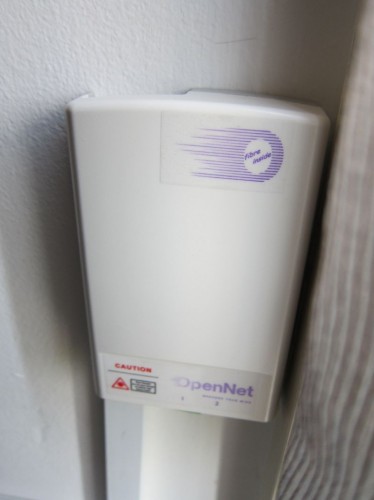The fibre optic cable may have reached your home, but when you try signing up for one of those speedy fibre broadband services that your friends have been talking about, you are told to wait several weeks or even months for the link to be “turned on”. The reason: the company rolling out the fibre can’t cope.
Though Opennet is meeting its deadline to connect up 95 per cent of Singapore by mid-2012 – it was at 86 per cent in January – it is finding it hard to keep up with the demand of customers signing up en masse during the quarterly IT bazaars, where prices for these services are often slashed.
Opennet may have the cable hooked up to homes and offices, but it still has to “turn on” or activate the switches at the base of a high-rise building, for example, to send the data through.
And that is the problem that the government regulator now wants to solve by making Opennet turn on more connections each month. Yesterday, it proposed a number of changes for Opennet, in a move that could accelerate the takeup of these faster and often cheaper broadband services.
Though the Infocomm Development Authority (IDA) stopped short of mandating just how many connections are to be turned on each week, it clearly said Opennet has to up its quota to meet new market realities. Specifically, it has told the company to cater to the seasonal spikes in demands at IT fairs in a review released yesterday.
When Opennet bid and won a S$750 million government grant in 2008 to lay fibre optic cables across the island, it was only required to activate 2,050 connections each week. But now, with more attractive services offered by ISPs, it has been receiving requests for about 3,000 a week on average, and as much as 5,000 a week when the quarterly tech bazaars draw in new subscriptions.
The immediate result: a lot of frustrated users who have a fibre point in their homes but no fibre service. The long-term problem? A slower-than-expected takeup of fibre services that could dampen the country’s boast of being a well-connected business and technology hub.
These are probably the reasons why the IDA is bringing about the much-needed changes now. A review of the interconnect offer, which lays out Opennet’s responsibilities, among other things, is not due until next year, but the regulator had decided to act early to fix the problem.
Will Opennet charge more for putting more men to work to activate more links? IDA has said clearly it should not because it is paid to roll out each link anyway. This means there should not be costs passed on to ISPs and then consumers.
The firm action is a good sign, of the determination to get things done right. Too often, regulators can be either too slow or reluctant to act when market conditions make services uncompetitive for consumers.
The situation, just a few years ago, before this next-gen broadband network was rolled out, was exactly that. A duopoly made up of SingTel and StarHub owned most of the telecom cables underground and decided they did not have to innovate or compete unduly hard for the consumer dollar. The result: uncompetitive broadband prices.
That has changed now, of course. With a network that can be leased or wholesaled to just about any service provider – there are 12 now, including ones targeting only businesses – the broadband market has enjoyed unprecedented competition.
Come next week, when the IT Show swings into town at Suntec City, don’t be surprised if M1 comes up with another S$39-a-month offer for a 100Mbps service, which it has promoted several times last year.
The proposed changes by IDA are not in time for that. But when they come into play in June or July, folks signing up for a speedy fibre service will likely face a shorter waiting time. And that’s certainly news to be cheered.







IDA lousy lah
My fibre line was activated in less than a week after installation. Woodlands area.
Take note. Fibre broadband contracts are not transferable and are tied to the physical location and not address of the customer.
When i wanted to sign up for a fibre broadband service, i checked with all the consumer ISPs on the possibility of transferring that contract to a new address as i might move. The reply from all of them were that I would incur termination charges and would need to reapply for a new line when I move.
What’s happening to Singapore? Instead of having a well monitored and executed plan, we wait until the last minute to press the emergency button.
Welcome to the REAL Singapore, where everything is not as nice as it seems, and things, systems are breaking down one by one.
Floods in Orchard Road, MRT breakdowns, systemic corruption in govt institutions, problem gambling (after two casinos? what a surprise!), overcrowding, social tensions with the highly-esteemed FTs etc.
———–
Okay, back to the topic of fiber broadband.
Do not be surprised that the big two telcos (Starhub and Singtel) will make use of their market reach and leverage to crowd out the other competitors.
For example, Singtel offers free additional fiber wiring and trunking for new subscribers. The catch? You’ll have to sign a 2-year contract with the red telco. It’ll also throw in some packaged perks (MIO tv, free X months of tv, free digital voice).
Starhub reaches out to its existing cable broadband customers, by coaxing them to switch to fiber broadband. Throw in free installation by ‘Hub Troopers’ and a free modem/router… and another Starhub MaxInfinity customer is procured.
With so many competitors, I seriously doubt the need to have lengthy contracts. 6 months should be the longest duration of any telco fiber broadband contract. Also, as a previous commenter had pointed out, the contracts are tied to a physical location and cannot be transferred once you move house. Therefore it makes even more sense to have shorter contracts.
Anyhow, the IDA had better get serious if it wants fiber uptake on the island to improve.